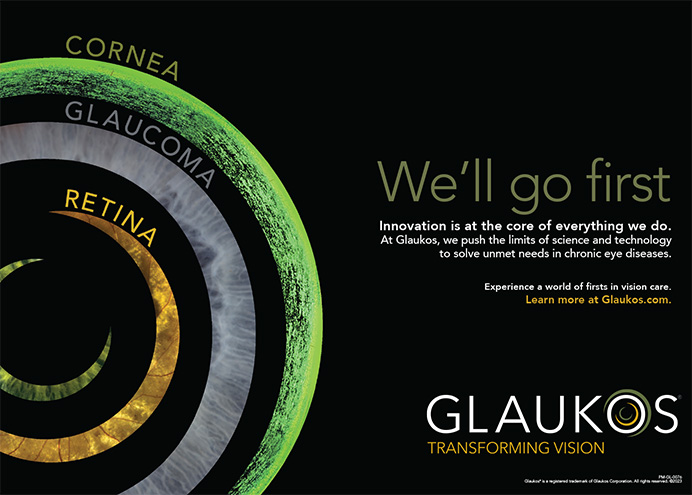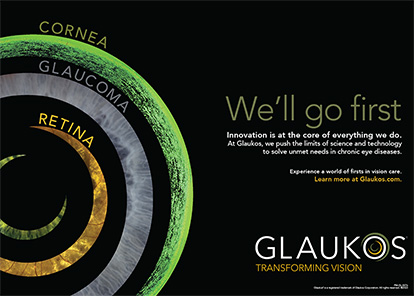

Reducing the Global Burden of Myopia by Delaying the Onset of Myopia and Reducing Myopic Progression in Children: The Academy’s Task Force on Myopia
Modjtahedi BS, Abbott RL, Fong DS, Lum F, Tan D; Task Force on Myopia1
Industry support: Some members of the task force reported receiving financial support from industry
ABSTRACT SUMMARY
In 2019, the AAO assembled a task force of physicians and scientists from around the world to evaluate and synthesize the scientific literature on myopia. The established methods of myopia prevention and control were examined and evaluated for evidence of their safety and efficacy. Based on this information, the task force developed a global action plan to address this public health issue.1
Study in Brief
An AAO task force evaluated the scientific literature on myopia and the established methods of its prevention and control in order to develop a global action plan to address this public health issue.
WHY IT MATTERS
The fight against the myopia pandemic will require decades of effort, and the onus is on adults to wage it at all levels of society.
The epidemiologic studies on myopia summarized by the task force indicate that the prevalence of myopia (≥ -0.50 D) will increase from 22.9% of the worldwide population in 2020 to 49.8% (43.4%–55.7%; 95% confidence interval) by 2050. Of the nearly 5 billion people with myopia in 2050, approximately 1 billion will have high myopia. Based on these statistics, Modjtahedi and colleagues describe a pandemic of myopia and call for global efforts comparable to those for the prevention and treatment of the COVID-19 pandemic.2-4
Risk factors. Apart from a genetic predisposition if both parents have myopia, the most important risk factor for developing the condition is extensive activity at close distance over time. The incidence of myopia therefore correlates with the educational level of the population. Children who grow up in an urban environment have a 2.6 times higher risk of developing myopia than those who grow up in a rural area. If both parents are highly myopic, a child’s risk of experiencing rapid elongation of the eye is disproportionately higher. The earlier that children need refractive correction of myopia, the faster that myopia develops and the more pronounced it is. The problem of myopia is not limited to countries in Far East Asia. Prevalence projections for 2050 were found to be lower in the United States, Australia, and Europe. The trend, however, was similar.5-7
Clinical significance. It is well known that glaucoma and cataract positively correlate with myopia.8,9 The Eye Disease Case-Control Study Group showed that, compared to nonmyopic eyes, eyes with a refractive error of -1.00 to -3.00 D and eyes with a refractive error greater than -3.00 D had a fourfold and tenfold higher risk, respectively, of idiopathic rhegmatogenous retinal detachment.10 Terms such as pathologic myopia, myopic degeneration, degenerative myopia, and myopic macular degeneration describe conditions that affect chorioretinal atrophy, all basically caused by eyeball or axial length elongation. Pathologic myopia is a major cause of age-related blindness, especially in Asia. In China, 20% of cases of functional age-related blindness are currently attributed to myopia. In Europe, myopia is the most common (25%) cause of functional blindness in people less than 75 years of age. Overall, for all ages, the rate in Europe is 6% to 9%, making myopia the second most common cause of functional blindness.3,11
Socioeconomic impact. Globally, visual impairment from uncorrected myopia results in an estimated $244 billion worth of lost productivity, and blindness from myopic macular degeneration results in $6 billion worth of lost productivity.12
Control strategies. Therapeutic approaches to curbing myopia progression include optical, pharmaceutical, and behavioral interventions. For example, spectacle- and contact lens–based approaches create a myopic defocus in the periphery of the retina and produce a modest treatment effect. Orthokeratology flattens the central cornea overnight to allow users to forego myopic correction during the day, and myopic progression also seemed to be reduced. A 2019 AAO Ophthalmic Technology Assessment cited safety as an important concern with orthokeratology because of a blinding risk due to microbial keratitis from extended contact lens wear. The clinical advantage of contact lenses for myopia control compared to lower-cost alternatives has not been proven yet.13
The administration of low (0.01%–0.1%) doses of atropine in early childhood and over many years was found in a 2017 AAO Ophthalmic Technology Assessment to be the most reasonable approach to myopia control. Compared to high doses of the drug, this strategy was associated with fewer side effects and less rebound myopia after cessation.14 A meta-analysis of 16 studies of myopia control with atropine demonstrated its effectiveness.15 There are no conclusive long-term studies, however, and patient adherence, which must be maintained over many years, is a major challenge with this approach.16
In terms of modifiable risk factors, the greatest amount of attention has been paid to increasing children’s time outdoors to reduce the risk of myopia onset. Some studies have shown that children who spend comparatively more time outdoors develop significantly shorter axial lengths. As little as 40 minutes of outdoor activity was reported to produce a significant difference from the control group in a 3-year study.17 In a meta-analysis, every extra hour spent outdoors per week reduced the risk of myopia progression by 2%.18 According to Modjtahedi et al,1 the current evidence showing that time outdoors slows myopia progression is minimal, but there is strong evidence that time outdoors delays or prevents the onset of myopia. Further research is required to determine the best type, amount, and duration of exposure.
DISCUSSION
The findings of the AAO’s Task Force on Myopia demand global action by all those involved in the eye care professions and industry. The first step is to raise public awareness of the problem, particularly among elected officials and political decision-makers. The gigantic socioeconomic challenge of early-onset functional age-related blindness due to high myopia has yet to be addressed. Considering that general life expectancy is predicted to increase significantly by the year 2050, people with high myopia may develop functional blindness earlier in life and may therefore be unable to lead a self-determined and fulfilled life for decades, instead requiring care.
The task force’s recommendations for action are relatively simple. The global need for higher education of the next generation must be offset by a commonsense level of free physical and play activity, especially outdoors. This should become a requirement of educational curricula starting when children are quite young. Therapy with low-dose atropine should be considered for children with a high genetic predisposition to developing myopia. In young adults, therapy with contact lenses or other optical devices may be the most appropriate control strategy.
The Risks and Benefits of Myopia Control
Bullimore MA, Ritchey ER, Shah S, Leveziel N, Bourne RRA, Flitcroft DI19
Industry support: Supported in part by CooperVision
ABSTRACT SUMMARY
This study examined whether the potential benefits of various interventions to slow the progression of myopia justified the potential risks of treatment.
Study in Brief
These investigators developed a model with which to examine the risks and benefits of available methods of myopia control and to contrast them with the omission of the measures.
WHY IT MATTERS
The prevalence of myopia is increasing worldwide. By addressing this risk with mitigating measures, the incidence of unnecessary visual impairment and complications can be reduced.
Bullimore et al19 used a model to calculate the risk of visual impairment as a function of myopia severity. Next, they estimated the years of visual impairment associated with different degrees of myopia. These results were related to the years of visual impairment that could have been prevented with achievable myopia control therapies.
The predicted mean years of visual impairment ranged from 4.42 for a person with -3.00 D of myopia to 9.56 years for a person with -8.00 D of myopia. A 1.00 D reduction in myopia progression shortened these times of visual impairment by 0.74 and 1.21 years, respectively.
Bullimore et al concluded that the potential benefits of therapeutic myopia control outweighed the associated risks.
DISCUSSION
The global prevalence of myopia is expected to increase sharply if no effective countermeasures are taken.2 Accordingly, the proportion of people with myopic maculopathy (also known as myopic macular degeneration) is also expected to increase significantly.11,20,21 The onset of myopic maculopathy is earlier—mostly in the 5th decade of life—than the onset of the age-related form of macular degeneration.22 For this reason, people with myopic maculopathy have comparatively more years of visual impairment. In Europe and China, visual impairment from myopic maculopathy is more common than vision loss from diabetic eye disease.23
This study thoroughly examines the incidence of the different diseases associated with myopia such as myopic maculopathy, cataract, retinal detachment, and glaucoma. Bullimore and colleagues calculated in detail the patient-years of most severe vision loss that can be expected with the most common comorbidities.19 A unique feature of this study is the theoretical model that Bullimore et al developed to contrast the risks and benefits of myopia control measures with the omission of such measures. Even if, for example, long-term treatment with contact lenses is associated with a high risk of infection, they suggest the benefits of the reduction in myopia progression achieved by this form of therapy and the comorbidities avoided as a result outweigh the risk.
Bullimore et al did not express a preference for a particular form of myopia control. The model calculations were based solely on the relatively manageable long-term data of the studies on which the individual procedures were based. In our estimation, this is a weak point of the study. Why, for example, isn’t behavioral therapy discussed? Several studies have found that time spent outdoors has at least as great a beneficial effect on myopia control in adolescents as the other therapies mentioned.24-26
This study does not address refractive surgery as a myopia control measure.19 Refractive surgery is a widely accepted treatment for myopia. Its utility for curbing myopia progression, however, is unclear and has not been scientifically established. The therapeutic approaches to myopia control examined by Bullimore et al are used in children and adolescents, whereas refractive surgery may not be performed on individuals under the age of 18 years (for good reason).
Myopia can increase significantly in people between the ages of 18 and 26 years. Intensified activity in the near range of vision associated with the training and studies of these individuals is thought to be the cause.27,28 It should not be difficult to determine whether refractive surgery exerts a stabilizing effect on myopia in this population. Neither retrospective nor controlled prospective studies on this subject, however, have been published in the peer-reviewed literature. This provides an opportunity for further research.
1. Modjtahedi BS, Abbott RL, Fong DS, Lum F, Tan D; Task Force on Myopia. Reducing the global burden of myopia by delaying the onset of myopia and reducing myopic progression in children: The Academy’s Task Force on Myopia. Ophthalmology. 2021;128(6):816-826.
2. Holden BA, Fricke TR, Wilson DA, et al. Global prevalence of myopia and high myopia and temporal trends from 2000 through 2050. Ophthalmology. 2016;123(5):1036-1042.
3. Tideman JW, Snabel MC, Tedja MS, et al. Association of axial length with risk of uncorrectable visual impairment for Europeans with myopia. JAMA Ophthalmol. 2016;134(12):1355-1363.
4. Ang M, Flanagan JL, Wong CW, et al. Review: myopia control strategies recommendations from the 2018 WHO/IAPB/BHVI Meeting on Myopia. Br J Ophthalmol. 2020;104(11):1482-1487.
5. Theophanous C, Modjtahedi BS, Batech M, Marlin DS, Luong TQ, Fong DS. Myopia prevalence and risk factors in children. Clin Ophthalmol. 2018;12:1581-1587.
6. Nickels S, Hopf S, Pfeiffer N, Schuster AK. Myopia is associated with education: results from NHANES 1999-2008. PLoS One. 2019;14(1):e0211196.
7. Zadnik K, Satariano WA, Mutti DO, Sholtz RI, Adams AJ. The effect of parental history of myopia on children’s eye size. JAMA. 1994;271(17):1323-1327.
8. Mitchell P, Hourihan F, Sandbach J, Wang JJ. The relationship between glaucoma and myopia: the Blue Mountains Eye Study. Ophthalmology. 1999;106(10):2010-2015.
9. Kanthan GL, Mitchell P, Rochtchina E, Cumming RG, Wang JJ. Myopia and the long-term incidence of cataract and cataract surgery: the Blue Mountains Eye Study. Clin Exp Ophthalmol. 2014;42(4):347-353.
10. Risk factors for idiopathic rhegmatogenous retinal detachment. The Eye Disease Case-Control Study Group. Am J Epidemiol. 1993;137(7):749-757.
11. Wong TY, Ferreira A, Hughes R, Carter G, Mitchell P. Epidemiology and disease burden of pathologic myopia and myopic choroidal neovascularization: an evidence-based systematic review. Am J Ophthalmol. 2014;157(1):9-25.e12.
12. Fricke TR, Holden BA, Wilson DA, et al. Global cost of correcting vision impairment from uncorrected refractive error. Bull World Health Organ. 2012;90(10):728-738.
13. Huang J, Wen D, Wang Q, et al. Efficacy comparison of 16 interventions for myopia control in children: a network meta-analysis. Ophthalmology. 2016;123(4):697-708.
14. Pineles SL, Kraker RT, VanderVeen DK, et al. Atropine for the prevention of myopia progression in children: a report by the American Academy of Ophthalmology. Ophthalmology. 2017;124(12):1857-1866.
15. Shih YF, Chen CH, Chou AC, Ho TC, Lin LL, Hung PT. Effects of different concentrations of atropine on controlling myopia in myopic children. J Ocul Pharmacol Ther. 1999;15(1):85-90.
16. Wu PC, Yang YH, Fang PC. The long-term results of using low-concentration atropine eye drops for controlling myopia progression in schoolchildren. J Ocul Pharmacol Ther. 2011;27(5):461-466.
17. He M, Xiang F, Zeng Y, et al. Effect of time spent outdoors at school on the development of myopia among children in China: a randomized clinical trial. JAMA. 2015;314(11):1142-1148.
18. Sherwin JC, Reacher MH, Keogh RH, Khawaja AP, Mackey DA, Foster PJ. The association between time spent outdoors and myopia in children and adolescents: a systematic review and meta-analysis. Ophthalmology. 2012;119(10):2141-2151.
19. Bullimore MA, Ritchey ER, Shah S, Leveziel N, Bourne RRA, Flitcroft DI. The Risks and Benefits of Myopia Control. Ophthalmology. Published online May 4, 2021. doi:10.1016/j.ophtha.2021.04.032
20. Pärssinen O, Kauppinen M. Risk factors for high myopia: a 22-year follow-up study from childhood to adulthood. Acta Ophthalmol. 2019;97(5):510-518.
21. Ueda E, Yasuda M, Fujiwara K, et al. Trends in the prevalence of myopia and myopic maculopathy in a Japanese population: The Hisayama Study. Invest Ophthalmol Vis Sci. 2019;60(8):2781-2786.
22. Cohen SY, Laroche A, Leguen Y, Soubrane G, Coscas GJ. Etiology of choroidal neovascularization in young patients. Ophthalmology. 1996;103(8):1241-1244.
23. Fricke TR, Jong M, Naidoo KS, et al. Global prevalence of visual impairment associated with myopic macular degeneration and temporal trends from 2000 through 2050: systematic review, meta-analysis and modelling. Br J Ophthalmol. 2018;102(7):855-862.
24. Rose KA, Morgan IG, Ip J, et al. Outdoor activity reduces the prevalence of myopia in children. Ophthalmology. 2008;115(8):1279-1285.
25. Guggenheim JA, Northstone K, McMahon G, et al. Time outdoors and physical activity as predictors of incident myopia in childhood: a prospective cohort study. Invest Ophthalmol Vis Sci. 2012;53(6):2856-2865.
26. Wu PC, Chen CT, Chang LC, et al. Increased time outdoors is followed by reversal of the long-term trend to reduced visual acuity in Taiwan primary school students. Ophthalmology. 2020;127(11):1462-1469.
27. Cumberland PM, Bao Y, Hysi PG, Foster PJ, Hammond CJ, Rahi JS; UK Biobank Eyes & Vision Consortium. Frequency and distribution of refractive error in adult life: methodology and findings of the UK Biobank Study. PLoS One. 2015;10(10):e0139780.
28. Williams KM, Verhoeven VJ, Cumberland P, et al. Prevalence of refractive error in Europe: the European Eye Epidemiology (E(3)) Consortium. Eur J Epidemiol. 2015;30(4):305-315.




